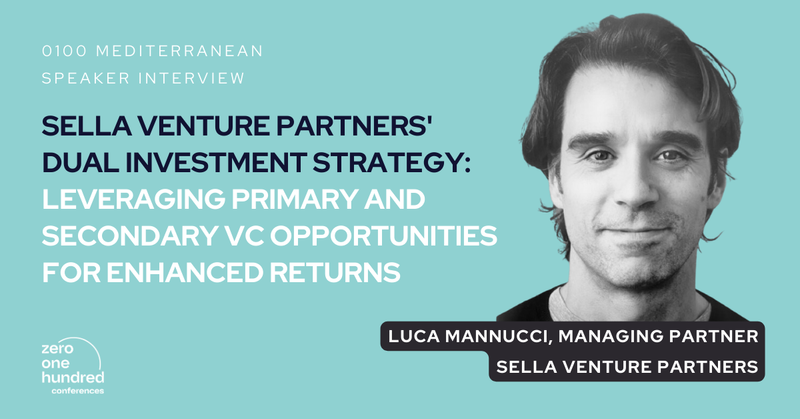Our latest speaker interview for the 0100 Conference Mediterranean features Luca Mannucci, Managing Partner at Sella Venture Partners, a renowned venture capital fund of funds investing in a diverse range of leading VC funds across North America and Europe.


In this interview, Luca shares valuable insights into their unique dual investment strategy, which blends 70% primary investments with 30% secondary investments. He also sheds light on the growing importance of secondary transactions in venture capital, the complexities of sourcing high-quality deals, and the sectors currently offering the most exciting opportunities for secondary investments.
Luca will be speaking on the panel, “VC Secondaries – The Market Opportunity and Ways to Select the Right Fund,” alongside industry leaders such as Matt Russell, Investment Director at VenCap International plc, and Nick Hendra, Venture Partner at AAF Management Ltd.
Could you provide an overview of Sella Venture Partners’ investment strategy?
At SVP, we focus on providing access to a selection of top-tier venture funds both in North America and Europe. Our strategy encompasses both primary and secondary fund investments. On the primary side, we invest in premier early-stage venture funds with a proven track record and persistent returns. On the secondary side, we focus on acquiring LP stakes in mature funds (at least 6 to 7 years), enabling us to tap into high-revenue, high-growth private tech companies with clear liquidity paths.
How do secondaries fit into your overall investment strategy, and how do they complement your primary investments?
Our investment strategy typically comprises 30% secondary investments and 70% primary investments. Primary commitments fuel the secondary market, allowing us to leverage our GP network and access highly restricted secondary deals, often unavailable to external buyers. This dual primary/secondary strategy offers significant advantages for our investors, in particular (i) we are able to significantly shorten the life span of our funds, and (ii) we can increase the size of overcommitment, ultimately improving net returns. Also, a positive side-effect of our secondaries investment activities is the reduced j-curve effect of our funds. As an example, our 2020 vintage fund avoided the typical j-curve thanks to the positive impact of our secondary investments.
How do you approach discounts when assessing a buying opportunity?
Discounts in VC secondaries are consistently higher than what you typically see in buyouts. This is due to many factors: (i) a scarcer level of information compared to the one that buyout opportunities provide, (ii) a higher number of restricted GPs. In the VC space, the approach of General Partners is to be more restrictive in selecting which LPs can enter their funds after formation, with the effect to limit competition and hence pricing for the seller, (iii) seniority and structure of equity. Especially in the case of early funds, NAV valuations of assets often need to be reassessed in light of the various stacks of preferred equities raised subsequently, as they often bring to the table liquidation preferences and other clauses that could significantly affect the value of the targeted shares.
In general, we see deals with an important level of discounts. While discounts are an attractive aspect, our main concern is the quality of the portfolio companies and their upside potential. Also, we rely a lot on the quality of the GP, as it will help impact the growing and exit potential of the various companies. Working a lot with GPs we know from our primary commitments represents a clear advantage.
How complex is it to have a good secondary deal flow?
Our deal flow mainly relies on strong relationships with GPs. With over 50 primary commitments underwritten, we benefit from an extensive origination network. Especially in today’s market, the average fund’s life of early-stage funds has lengthened significantly. It is often the case that some LPs require liquidity after some years. We often approach our network of GPs as a solution provider for those LPs that cannot sit longer on their illiquid assets. Aside from this we also use some intermediaries.
Sella Venture Partners focuses on smaller transactions, with a deal value below $5 million but in some cases also around $1-2 million in size. This gives us a good edge on deal flow, as we do not see a lot of organized buyers for deals in this range.
What are the key drivers behind the growth of secondary transactions in the VC market?
The first factor is certainly the growth of VC. If we compare the size of funds raised, In the last ten years, approximately 2 trillion was raised by VC funds. This represents over 5x the capital raised in the previous ten years. These substantial inflows of capital led to a proliferation of private companies that can remain private longer without needing to go public. The time it takes for startups to go public or be acquired has significantly increased, often stretching from 5-8 years to 8-15 years. This extended timeline creates a pressing need for liquidity among investors (both GPs and LPs) who may want to realize returns before a company reaches an exit event. The secondary market represents an opportunity for those GPs who are willing to generate liquidity for their limited partners by proactively managing assets rather than waiting for an exit. In addition, some innovative deal structures have emerged, making secondary transactions more attractive and accessible. As an example, today venture capital GPs are increasingly facilitating GP-led secondary transactions, allowing them to maintain control over high-quality assets while providing liquidity to LPs.
Are there specific sectors that you find more attractive for VC secondary investments?
During 2024 we have been very busy, with a high-quality dealflow both in software and life science funds. On the secondary side, we like to have a value approach, i.e. to look at those opportunities that are underseen by investors. Today sectors such as blockchain, Saas, fintech, and also life science are the ones where we see the most attractive opportunities.

